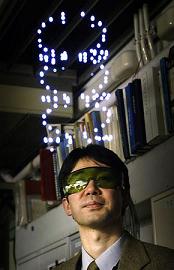Equations as icons
Monday, March 12, 2007, 06:08 PM - Beautiful Code, Media
When the 14-year-old Richard Feynman first encountered eiπ + 1 = 0, the future physics Nobel laureate wrote in big, bold letters in his diary that it was "the most remarkable formula in math". Stanford University mathematics professor Keith Devlin claims that "like a Shakespearean sonnet that captures the very essence of love, or a painting that brings out the beauty of the human form that is far more than just skin deep, Euler's equation reaches down into the very depths of existence". Meanwhile Paul Nahin – a retired US electrical engineer – says in his recent book, Dr Euler's Fabulous Formula, that the expression sets "the gold standard for mathematical beauty".Keep reading Equations as icons by Robert P. Crease, chairman of the Department of Philosophy, Stony Brook University, and historian at the Brookhaven National Laboratory, US.
For some people this expression, named after the 18th-century Swiss mathematician Leonhard Euler, even seems to have become an icon, having special significance apart from its mathematical context. It once even served as a piece of evidence in a criminal trial. In August 2003 an eco-terrorist assault on several car dealerships in the Los Angeles area resulted in millions of dollars worth of damage when a building was set alight and over 100 vehicles were destroyed or defaced. The vandalism included graffiti on the cars that read "gas guzzler" and "killer" – and, on one Mitsubishi Montero, eiπ + 1 = 0. Using this as a clue and later as evidence, the FBI arrested William Cottrell, a graduate student in theoretical physics at the California Institute of Technology, who was later tried and convicted. Cottrell testified at his trial that "Everyone should know Euler's theorem".
PLAY ME VI
Wednesday, February 14, 2007, 12:26 AM - Beautiful Code

inside eBay's Innovation Machine
Thursday, January 4, 2007, 04:39 PM - Beautiful Code, Media
Business is steady on an early december afternoon at the iSold It consignment store on Skeet Club Road in High Point, N.C., as customers drop off items to be sold on eBay. Bikes, electronics, power tools --a steady flow of stuff, forming a tributary to the nearly $50 billion flood of goods and services that will be sold on the giant online marketplace in 2006.
iSold It LLC, with almost 200 outlets from coast to coast, has become one of the largest sellers on eBay Inc. by making it simple for anyone to move merchandise across the sprawling auction site. Simple for the folks consigning the stuff, that is -they just fill out a quick form, then go home to watch their online auction and wait for a check- but a fair amount of work for iSold It's employees, who must check the items in, list them in the most advantageous areas on eBay, keep track of bidding and sales, and follow through with shipping and payment.
Multiply that by the 50,000 different auctions iSold It manages in a typical month -about 15,000 at any given moment, closer to 18,000 during the December holiday rush- and, well, "it gets very complex," says Dave Crocker, senior vice president of business development at the privately held Monrovia, Calif., company. To deal with that complexity, iSold It is switching from internally developed software to a more sophisticated application from a Salt Lake City firm called Infopia Inc., which links directly to various eBay sites and handles pricing, listing and other key tasks more efficiently.
Infopia is not just another software vendor. It's part of a growing community of some 40,000 independent developers, all building products using eBay's own application programming interfaces, or APIs -the connection points that let a program share data and respond to requests from other software. These applications are tailor-made to work seamlessly with eBay's core computing platform. eBay provides its APIs to the developers for free; its cost is limited to maintaining the code and providing some support resources for the developers.
The payoff: a network of companies creating applications that help make eBay work better, grow faster and reach a broader customer base. (eBay's other business units, Skype and PayPal, also have open APIs and developer programs.) eBay says that software created by its developer network—there are more than 3,000 actively used applications, including a configurator that allows high-volume sellers to list items more efficiently, and a program that notifies buyers of auction status via mobile phone -plays a role in 25 percent of listings on the U.S. eBay site. The company has about 105 million listed items at any given time; roughly half of its sales come from within the United States.
Sharing APIs is common practice for software companies, but eBay, along with its fellow online-retail pioneer, Amazon.com, is breaking new ground in its industry by establishing a large community of outside developers. And the implications of this strategy go much further than the world of auctions and electronic storefronts. "It's about allowing people outside your company to write services that communicate with you-—it could be companies in your supply chain, sharing information about inventories or billing," says Adam Trachtenberg, senior manager of platform evangelism at eBay (i.e., the guy responsible for the care and feeding of the developer program).
"In the next few years you will see more and more companies with third-party developer networks, even companies you might not think of as likely candidates," adds Zeus Kerravala, senior vice president of enterprise research at Yankee Group. That could mean companies in far more traditional businesses than eBay, including manufacturers, he says. "These days, executives are telling me 'we're more like a software company than a hardware company'—and I say, then act like one. The long-term winners and losers in markets are determined by ecosystems around them, and developer networks fit that model. Developer communities allow companies to do things over the Internet with resources they don't have themselves," he says. Companies can't just flip a switch and join the game, though, says Daniel Sholler, a research vice president at Gartner Inc. They may need to first embrace the design model of service-oriented architecture, which hides the underlying complexity of a system from users, and allows components of an IT infrastructure to be reused and recombined to support particular processes instead of dedicated tasks. "This is part of the maturation of the Web, the trend toward service-enabling all kinds of systems and sharing information more freely," Sholler says.
Companies such as Infopia are now creating mash-ups—applications built around APIs from eBay and other firms such as SalesForce.com Inc. and FedEx Corp.—that extend the relationship between different companies and their customers. The mash-ups loosely join unrelated entities, portending a new level of interactivity between companies and customers of all kinds. "This is what Web 2.0 does for business," says Infopia CEO Bjorn Espenes. "Everyone can pick and share information in different ways that are much more automated."
Keep reading Inside eBay by Edward Cone at Cio insight!
Five Steps to Font Freedom
Monday, May 1, 2006, 03:02 PM - Beautiful Code, Copyfight
Think about these scenarios: You don't need to own a font to read a book set in Goudy. You don't need to own Futura to watch a Wes Anderson film. You don't need to own Times to read the Times. You don't need to own any fonts to watch television. Why not? Because that would be insane. And yet this same logic doesn't apply on the internet. Online, a person needs to own a fully licensed version of a font in order to view it in a web browser. You are reading Arial right now. That's right, Arial. Why? Because everybody on Earth has a licensed version of Arial on their computer. The great democracy of the internet has failed to produce typography any better than the least common denominator of system fonts. As a designer, I hope you are outraged and offended. So what can you do about it?
link
via
projecting 3D (like you just don't care)
Monday, March 6, 2006, 12:57 PM - Beautiful Code, Games
 The National Institute of Advanced Industrial Science and Technology (AIST) has built a system that projects 3D images in less that it takes to say 'hollogram'. The device projevts "real 3D images" which consist of dot arrays in space where there is nothing but air.
The National Institute of Advanced Industrial Science and Technology (AIST) has built a system that projects 3D images in less that it takes to say 'hollogram'. The device projevts "real 3D images" which consist of dot arrays in space where there is nothing but air.
"Until now, projected three-dimensional imagery has been artificial; optical illusions that appear 3D due to the parallax difference between the eyes of the observer. Prolonged viewing of this conventional sort of 3D imagery can cause physical discomfort. The newly developed device, however, creates real 3D images by using laser light, which is focused through a lens at points in space above the device, to create plasma emissions from the nitrogen and oxygen in the air at the point of focus. Because plasma emission continues for a short period of time, the device is able to create 3D images by moving the point of focus."
link to the project
via dottocomu
Turing's cathedral
Monday, February 27, 2006, 02:42 AM - Beautiful Code, Theory

The digital universe was conceived by Old Testament prophets (led by Leibniz) who supplied the logic, and delivered by New Testament prophets (led by von Neumann) who supplied the machines. Alan Turing (1912-1954) formed the bridge between the two.
In a digital computer, the instructions are in the form of COMMAND (ADDRESS) where the address is an exact (either absolute or relative) memory location, a process that translates informally into "DO THIS with what you find HERE and go THERE with the result." Everything depends not only on precise instructions, but on HERE, THERE, and WHEN being exactly defined. It is almost incomprehensible that programs amounting to millions of lines of code, written by teams of hundreds of people, are able to go out into the computational universe and function as well as they do given that one bit in the wrong place (or the wrong time) can bring the process to a halt.
Biology has taken a completely different approach. There is no von Neumann address matrix, just a molecular soup, and the instructions say simply "DO THIS with the next copy of THAT which comes along." The results are far more robust. There is no unforgiving central address authority, and no unforgiving central clock. This ability to take general, organized advantage of local, haphazard processes is exactly the ability that (so far) has distinguished information processing in living organisms from information processing by digital computers.
READ Turing's Cathedral by George Dyson.
The Nature of Code
Saturday, January 21, 2006, 12:27 AM - Beautiful Code

Can we capture the unpredictable evolutionary and emergent properties of nature in software? Can understanding the mathematical principles behind our physical world world help us to create digital worlds? This class will focus on the programming strategies and techniques behind computer simulations of natural systems. We’ll explore topics ranging from basic mathematics and physics concepts to more advanced simulations of complex systems. Subjects covered will include forces, trigonometry, fractals, cellular automata, self-organization, and genetic algorithms. Examples will be demonstrated using Processing with a focus on object oriented programming.
Learn the way of the code with Daniel Shiffman. First week already online!
Blink!
Next












